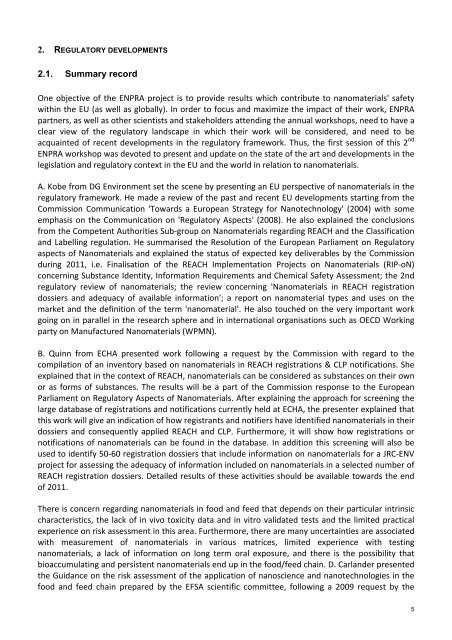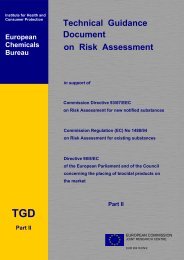Challenges of Regulation and Risk Assessment of Nanomaterials
Challenges of Regulation and Risk Assessment of Nanomaterials
Challenges of Regulation and Risk Assessment of Nanomaterials
You also want an ePaper? Increase the reach of your titles
YUMPU automatically turns print PDFs into web optimized ePapers that Google loves.
2. REGULATORY DEVELOPMENTS<br />
2.1. Summary record<br />
One objective <strong>of</strong> the ENPRA project is to provide results which contribute to nanomaterials' safety<br />
within the EU (as well as globally). In order to focus <strong>and</strong> maximize the impact <strong>of</strong> their work, ENPRA<br />
partners, as well as other scientists <strong>and</strong> stakeholders attending the annual workshops, need to have a<br />
clear view <strong>of</strong> the regulatory l<strong>and</strong>scape in which their work will be considered, <strong>and</strong> need to be<br />
acquainted <strong>of</strong> recent developments in the regulatory framework. Thus, the first session <strong>of</strong> this 2 nd<br />
ENPRA workshop was devoted to present <strong>and</strong> update on the state <strong>of</strong> the art <strong>and</strong> developments in the<br />
legislation <strong>and</strong> regulatory context in the EU <strong>and</strong> the world in relation to nanomaterials.<br />
A. Kobe from DG Environment set the scene by presenting an EU perspective <strong>of</strong> nanomaterials in the<br />
regulatory framework. He made a review <strong>of</strong> the past <strong>and</strong> recent EU developments starting from the<br />
Commission Communication 'Towards a European Strategy for Nanotechnology' (2004) with some<br />
emphasis on the Communication on 'Regulatory Aspects' (2008). He also explained the conclusions<br />
from the Competent Authorities Sub-group on <strong>Nanomaterials</strong> regarding REACH <strong>and</strong> the Classification<br />
<strong>and</strong> Labelling regulation. He summarised the Resolution <strong>of</strong> the European Parliament on Regulatory<br />
aspects <strong>of</strong> <strong>Nanomaterials</strong> <strong>and</strong> explained the status <strong>of</strong> expected key deliverables by the Commission<br />
during 2011, i.e. Finalisation <strong>of</strong> the REACH Implementation Projects on <strong>Nanomaterials</strong> (RIP-oN)<br />
concerning Substance Identity, Information Requirements <strong>and</strong> Chemical Safety <strong>Assessment</strong>; the 2nd<br />
regulatory review <strong>of</strong> nanomaterials; the review concerning '<strong>Nanomaterials</strong> in REACH registration<br />
dossiers <strong>and</strong> adequacy <strong>of</strong> available information'; a report on nanomaterial types <strong>and</strong> uses on the<br />
market <strong>and</strong> the definition <strong>of</strong> the term 'nanomaterial'. He also touched on the very important work<br />
going on in parallel in the research sphere <strong>and</strong> in international organisations such as OECD Working<br />
party on Manufactured <strong>Nanomaterials</strong> (WPMN).<br />
B. Quinn from ECHA presented work following a request by the Commission with regard to the<br />
compilation <strong>of</strong> an inventory based on nanomaterials in REACH registrations & CLP notifications. She<br />
explained that in the context <strong>of</strong> REACH, nanomaterials can be considered as substances on their own<br />
or as forms <strong>of</strong> substances. The results will be a part <strong>of</strong> the Commission response to the European<br />
Parliament on Regulatory Aspects <strong>of</strong> <strong>Nanomaterials</strong>. After explaining the approach for screening the<br />
large database <strong>of</strong> registrations <strong>and</strong> notifications currently held at ECHA, the presenter explained that<br />
this work will give an indication <strong>of</strong> how registrants <strong>and</strong> notifiers have identified nanomaterials in their<br />
dossiers <strong>and</strong> consequently applied REACH <strong>and</strong> CLP. Furthermore, it will show how registrations or<br />
notifications <strong>of</strong> nanomaterials can be found in the database. In addition this screening will also be<br />
used to identify 50-60 registration dossiers that include information on nanomaterials for a JRC-ENV<br />
project for assessing the adequacy <strong>of</strong> information included on nanomaterials in a selected number <strong>of</strong><br />
REACH registration dossiers. Detailed results <strong>of</strong> these activities should be available towards the end<br />
<strong>of</strong> 2011.<br />
There is concern regarding nanomaterials in food <strong>and</strong> feed that depends on their particular intrinsic<br />
characteristics, the lack <strong>of</strong> in vivo toxicity data <strong>and</strong> in vitro validated tests <strong>and</strong> the limited practical<br />
experience on risk assessment in this area. Furthermore, there are many uncertainties are associated<br />
with measurement <strong>of</strong> nanomaterials in various matrices, limited experience with testing<br />
nanomaterials, a lack <strong>of</strong> information on long term oral exposure, <strong>and</strong> there is the possibility that<br />
bioaccumulating <strong>and</strong> persistent nanomaterials end up in the food/feed chain. D. Carl<strong>and</strong>er presented<br />
the Guidance on the risk assessment <strong>of</strong> the application <strong>of</strong> nanoscience <strong>and</strong> nanotechnologies in the<br />
food <strong>and</strong> feed chain prepared by the EFSA scientific committee, following a 2009 request by the<br />
5








